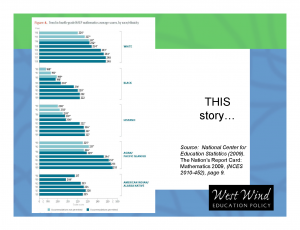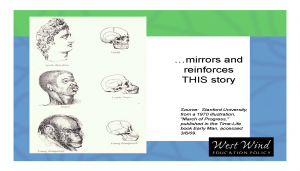Creating Risk
Minnesota state officials recently released the Minnesota Readiness Study showing that children of color and children who live in poverty are “less likely to be considered ready for kindergarten”[1] than their White and middle class counterparts. As we try to understand, I want to focus attention on the notion of what it means to be “ready” for kindergarten.
According to a 2010 report[2] summary, the Minnesota Department of Education defines readiness as:
The skills, knowledge, behaviors, and accomplishments that children should know and be able to do as they enter kindergarten in the following areas of child development: personal and social development; language and literacy; mathematical thinking; physical development; the arts.[3]
Although I understand given the pressure to produce a highly educated and qualified citizenry that there is such emphasis of skill and knowledge development for five year olds; I do believe that these indicators, don’t tell the full story. Not only that, but I am even more alarmed when last year’s summary goes on to “[c]onclud[e] that the result of the School Readiness Study are predictive of the Minnesota Comprehensive Assessment (MCA) proficiency outcomes at grade three, especially in reading and math…”[4]
Essentially this report, like so many others like it, indicates that poor children and children of color not only enter school behind, but are more likely not to catch up to their White and middle class peers even by third grade. To go further, many education reports like these and the subsequent media coverage contribute to a narrative and mental model that lead people to believe that it is the fault of the parents, the home environment, the culture, or circumstances that no one can control that leads to such disparate outcomes. This is implied due to the emphasis that these kids are behind even before they enter school. However, for a moment, let’s suppose we take this at face value and agree children enter into kindergarten at different levels of “readiness” in terms of their skills and knowledge. So what? To me, the obvious solution is to teach them the skills they need to be “ready” for kindergarten. Is that such a radical notion? It is true that learning accumulates with some skills building from others, but does that mean that once behind, always behind? I would guess that in a country like our own that prides itself on upward mobility and the self-making of each citizen, the rather obvious conclusion should be no. Yet, that’s exactly what happens. Why?
To answer this, I go back to one of the first texts I read as a graduate student, Shirley Brice Heath’s Ways with Words (1983)[5]. She studied three communities, Roadville, a predominantly White working class community; Trackton, a predominantly Black working class community; and the Townspeople, a more racially mixed middle-class community. She examined the orientation and use of language that each community exhibited in their day-to-day interactions amongst each other, and especially with their young children and looked at how their relationship with literacy and language related to their children’s degrees of success in school. Heath found that each set of students entered with different relationships, understanding, skills, and knowledge of literacy and that school heavily favored the orientation and skills that the Townspeople’s children brought with them to the detriment to the other students. It wasn’t that children from Trackton and Roadville didn’t know, but that they had different ways with words. Specifically Heath (1983) says, “The school’s approach to reading and learning establishes decontextualized skills as foundational in the hierarchy of academic skills,” (p. 353) which indicates the need to reassess how school approaches such skills and knowledge and examines who is privileged in this process and who is marginalized. Without this understanding and without taking the time to examine the taken-for-granted knowledge and skills teachers bring from their own homes and then perpetuate in the classroom, the achievement gap will continue to exist. As she says,
The school is not a neutral objective arena; it is an institution which has the goal of changing people’s values, skills, and knowledge bases. Yet some portions of the population, such as the townspeople, bring with them to school linguistic and cultural capital accumulated through hundreds of thousands of occasions for practicing the skills and espousing the values the schools transmit…
In any case, unless the boundaries between classrooms and communities can be broken, and the flow of cultural patterns between them encouraged, the schools will continue to legitimate and reproduce communities of townspeople who control and limit the potential progress of other communities and who themselves remain untouched by other values and ways of life (p. 367-369).
My point is that such reports, while sounding the alarm are indicating all the wrong sources for the achievement gap. It is not that students enter kindergarten deficit of skills, it’s that kindergarten in its current form is not created to recognize and honor the skills children bring with them and utilize those skills as a means of learning others. It’s a lack of knowledge, interest, and skills built into the institution itself that fails to welcome all its citizenry with the same equitable embrace as those who best exhibit the institution’s own ideologies and ways of knowing and being. Until we change that, I believe we will continue to create risk where none actually exists.
[1] See Tom Weber, “Achievement gap exists for kids even before kindergarten” Minnesota Public Radio.
[2] Due to technical errors, the report from this year is inaccessible online; therefore, I used the summaries and results from last year’s report, which makes many of the same points.
[4] Also see the School Readiness Study Summary.
[5] Heath, Ways with Words Cambridge, UK: Cambridge University Press.


 When I first became a teacher, honestly, I didn’t think race mattered. As a child who grew up in single-parent, low-income household, when I first graduated college, I felt I was the “model” of the American Dream. As a homeowner, mother, wife, college graduate, there were many reasons for why I didn’t challenge the paradigm that I was the exception.
When I first became a teacher, honestly, I didn’t think race mattered. As a child who grew up in single-parent, low-income household, when I first graduated college, I felt I was the “model” of the American Dream. As a homeowner, mother, wife, college graduate, there were many reasons for why I didn’t challenge the paradigm that I was the exception.
 I recently served as a process observer during a discussion about how to best support the central office leadership of a local school district as they planned school improvement efforts. The individuals who offered support to the district leaders commented on how frequently they heard these school leaders say, “We tried that, but…” followed by the discouraged refrain, “we didn’t get results.”
I recently served as a process observer during a discussion about how to best support the central office leadership of a local school district as they planned school improvement efforts. The individuals who offered support to the district leaders commented on how frequently they heard these school leaders say, “We tried that, but…” followed by the discouraged refrain, “we didn’t get results.”

 Last week on September 28, 2011, President Obama addressed the students of the nation from Benjamin Bannecker Academic High School in Washington, D.C. This was his third annual back-to-school address to the nation’s students and the second one I watched with my son, Finn. Finn is in first grade and will soon be seven. For the first time, this year he was old enough to know that the President was speaking to him and his classmates. It was truly enlightening for me to sit with him this year and hear what the President had to say from the perspective of a six-year-old.
Last week on September 28, 2011, President Obama addressed the students of the nation from Benjamin Bannecker Academic High School in Washington, D.C. This was his third annual back-to-school address to the nation’s students and the second one I watched with my son, Finn. Finn is in first grade and will soon be seven. For the first time, this year he was old enough to know that the President was speaking to him and his classmates. It was truly enlightening for me to sit with him this year and hear what the President had to say from the perspective of a six-year-old.